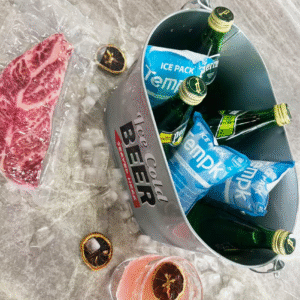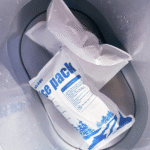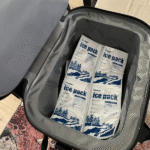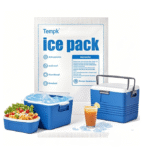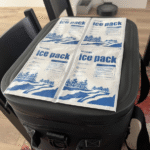Paket Es Kering untuk Pengiriman Makanan Laut: Praktik Terbaik untuk 2025
Pengiriman makanan laut menuntut ketelitian, terutama dalam hal pengendalian suhu. Mempertahankan suhu yang tepat selama transit sangat penting untuk memastikan makanan laut tiba dalam keadaan segar, aman, dan bebas dari pembusukan. Paket es kering, dengan kemampuannya mempertahankan suhu yang sangat rendah tanpa meninggalkan kelembapan, sangat penting untuk menjaga makanan laut tetap beku selama transportasi. Dalam panduan ini, kita akan mengeksplorasi efektivitas es kering untuk pengiriman makanan laut, menguraikan praktik terbaik untuk menggunakannya, dan mendiskusikan pertimbangan utama agar pengiriman berhasil 2025.
-
Bagaimana cara kantong es kering mengawetkan makanan laut selama pengiriman?
-
Untuk apa praktik terbaiknya pengiriman makanan laut dengan bungkus es kering?
-
Berapa banyak es kering yang dibutuhkan untuk pengiriman makanan laut?
-
Apa pertimbangan utama dalam memilih paket es kering untuk makanan laut??
Bagaimana cara kantong es kering mengawetkan makanan laut selama pengiriman?
Es kering, atau karbon dioksida padat, menyublim langsung dari padat menjadi gas pada -78,5°C (-109.3° f), yang membantu menjaga suhu beku yang diperlukan untuk makanan laut selama transit. Berbeda dengan kemasan gel atau es basah, es kering tidak meninggalkan residu cair apa pun, yang dapat merusak makanan laut karena mempengaruhi teksturnya atau memasukkan kontaminan. Es kering menjaga makanan laut tetap beku tanpa risiko pembusukan akibat pencairan atau pertumbuhan bakteri.
Manfaat Utama:
Es kering sangat efektif dalam mempertahankan suhu rendah tanpa menimbulkan kelembapan, memastikan makanan laut tetap beku dan segar untuk waktu yang lama.
Untuk tipnya:
Kantong es kering seberat 10 pon dapat mempertahankan suhu -78,5°C selama sekitar 24 jam, ideal untuk pengiriman makanan laut yang lebih pendek. Untuk waktu pengiriman yang diperpanjang, es kering tambahan mungkin diperlukan.
Bagaimana kantong es kering menjaga suhu
Proses sublimasi es kering membantu makanan laut tetap beku, bahkan dalam transportasi non-pendingin. Bila digunakan dengan wadah terisolasi, es kering memperpanjang kesegaran makanan laut dengan menciptakan lingkungan dingin dan mencegah pertumbuhan bakteri. Insulasi membantu menahan udara dingin dan memperlambat proses sublimasi es kering, memastikan makanan laut Anda tetap pada suhu yang diinginkan selama mungkin.
| Jenis item | Penggunaan Es Kering | Manfaat |
|---|---|---|
| Hidangan laut | 5-10 pon per 24 jam | Mencegah pencairan, menjaga kesegaran |
| Daging | 5-10 pon per 24-48 jam | Mencegah pembusukan dan pertumbuhan bakteri |
| Barang Beku | 4-6 pon per 24 jam | Mempertahankan keadaan beku, mencegah pencairan |
Praktik terbaik untuk mengirimkan makanan laut dengan bungkus es kering
Untuk memastikan penggunaan es kering yang paling efektif saat mengirimkan makanan laut, Ikuti praktik terbaik ini:
-
Gunakan es kering dalam jumlah yang tepat: Untuk pengiriman 24 jam, menggunakan 5-10 Es kering. Untuk pengiriman yang berlangsung hingga 48 jam, Pertimbangkan untuk menggunakan 10-15 pound, tergantung pada isolasi dan kondisi pengiriman.
-
Isolasi wadah pengiriman: Pastikan kontainer pengiriman diisolasi dengan benar untuk menjaga suhu dingin selama mungkin. Insulasi yang baik memperlambat sublimasi dan menjaga kualitas makanan laut.
-
Sisakan ruang untuk ventilasi: Es kering menyublim menjadi gas, dan gas harus keluar dari wadah untuk menghindari penumpukan tekanan. Selalu sisakan ruang untuk ventilasi.
-
Kemas makanan laut dengan benar: Letakkan es kering di dasar wadah, memastikan bahwa makanan laut tetap berada di atas es. Penempatan ini memastikan makanan laut tetap dingin tanpa kontak langsung dengan es kering.
Catatan penting: Selalu verifikasi peraturan yang mengatur pengiriman es kering di wilayah Anda, karena yurisdiksi tertentu memerlukan pelabelan dan dokumentasi khusus.
Berapa banyak es kering yang dibutuhkan untuk pengiriman makanan laut?
Jumlah es kering yang dibutuhkan bergantung pada beberapa faktor, termasuk besar kecilnya kiriman, durasi transit, dan isolasi yang digunakan. Pedoman umum adalah menggunakan 5-10 pon es kering per 24-48 jam transit. Namun, sebaiknya selalu disesuaikan berdasarkan kondisi lingkungan dan durasi pengiriman.
Contoh perhitungan
Untuk pengiriman yang tahan lama 36 jam, Anda akan membutuhkan kira-kira 10-15 Es kering, tergantung pada kemasan dan kondisi lingkungan.
| Durasi Pengiriman | Diperlukan Es Kering | Rekomendasi Pengepakan |
|---|---|---|
| Hingga 24 jam | 5-10 lbs | Wadah berinsulasi standar |
| Hingga 48 jam | 10-15 lbs | Insulasi tingkat lanjut atau beberapa lapis es kering |
Pertimbangan utama saat memilih paket es kering untuk pengiriman makanan laut
Saat memilih es kering untuk pengiriman makanan laut, ada beberapa faktor penting yang perlu dipertimbangkan:
-
Persyaratan suhu: Pastikan es kering mempertahankan suhu yang dapat menjaga makanan laut tetap beku. Suhu harus tetap di bawah -18°C (0° f) untuk mencegah pencairan.
-
Kualitas isolasi: Semakin baik insulasi pada kontainer pengiriman Anda, Semakin lama es kering akan bertahan, mengurangi frekuensi pengisian ulang yang diperlukan.
-
Ukuran dan pas: Perlengkapan pengiriman harus berukuran tepat agar dapat memuat makanan laut dan es kering. Wadah yang terlalu kecil tidak efisien, sedangkan wadah yang terlalu besar dapat menyebabkan sublimasi yang tidak diperlukan.
-
Kepatuhan terhadap peraturan: Pastikan kiriman Anda mematuhi peraturan lokal dan internasional mengenai es kering. Pelabelan dan dokumentasi yang tepat diperlukan untuk memastikan pengangkutan es kering yang aman.
Tip untuk pengiriman internasional: Selalu periksa pedoman negara tujuan untuk peraturan es kering, karena peraturan mungkin berbeda secara signifikan.
2025 Tren Pengiriman Es Kering untuk Makanan Laut
Seiring berkembangnya industri logistik rantai dingin, beberapa inovasi dan tren membentuk masa depan pengiriman makanan laut:
Kontainer pengiriman yang cerdas
Integrasi teknologi dalam pengiriman es kering telah menghasilkan pengembangan kontainer pengiriman cerdas dengan sensor suhu internal. Sensor ini dapat memberikan peringatan secara real-time jika suhu berada di luar kisaran yang dapat diterima, memastikan bahwa makanan laut tetap pada suhu ideal selama transit.
Bahan ramah lingkungan
Keprihatinan terhadap lingkungan mendorong industri ini menuju praktik yang lebih berkelanjutan. Banyak perusahaan yang mengadopsi bahan ramah lingkungan, seperti isolasi biodegradable dan kemasan yang dapat didaur ulang, untuk mengurangi dampak lingkungan dari pengiriman es kering.
Peningkatan produksi es kering
Kemajuan dalam produksi es kering membuatnya lebih efisien dan hemat biaya, memungkinkan dunia usaha mengurangi biaya operasional dan menyediakan solusi pengiriman yang lebih terjangkau untuk barang-barang yang mudah rusak.
Pertanyaan yang sering diajukan
Pertanyaan 1: Berapa banyak es kering yang dibutuhkan untuk mengirimkan makanan laut 24 jam?
Khas, 5-10 pon es kering cukup untuk pengiriman makanan laut 24 jam. Selalu sesuaikan jumlahnya tergantung pada kondisi spesifik pengiriman.
Pertanyaan 2: Bisakah es kering digunakan untuk pengiriman makanan laut hidup?
Sedangkan es kering efektif untuk pengiriman makanan laut beku, tidak cocok untuk makanan laut hidup. Kerang hidup memerlukan suhu di atas titik beku dan memerlukan ventilasi yang baik untuk menghindari mati lemas. Untuk makanan laut hidup, paket gel atau es basah adalah pilihan yang lebih baik.
Kesimpulan dan Saran
Menggunakan es kering untuk mengirimkan makanan laut memastikan produk Anda tetap beku selama transit, menjaga kesegarannya dan mencegah pembusukan. Dengan mengikuti praktik terbaik untuk pengepakan, memilih jumlah es kering yang benar, dan memastikan kepatuhan terhadap peraturan pengiriman, Anda berhasil mengangkut makanan laut dengan tetap menjaga kualitas produk.
Saran Tindakan: Jika Anda berencana mengirimkan makanan laut, konsultasikan dengan penyedia logistik untuk menentukan kebutuhan es kering terbaik dan metode pengiriman yang disesuaikan dengan kebutuhan Anda.
Tentang tempk
Dan Tempk, kami mengkhususkan diri dalam menyediakan solusi logistik rantai dingin canggih untuk barang yang mudah rusak, termasuk makanan laut. Perlengkapan pengiriman es kering dan wadah berinsulasi kami memastikan produk Anda tetap segar dan aman selama transit.
Panggilan untuk bertindak: Hubungi Tempk hari ini untuk mendapatkan saran ahli mengenai perlengkapan pengiriman es kering dan solusi rantai dingin lainnya yang disesuaikan dengan kebutuhan pengiriman makanan laut Anda.






